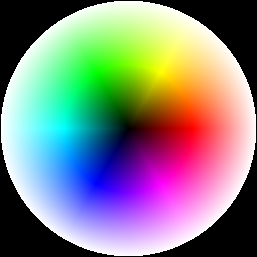
This is a generated color wheel bitmap ... where the outer edge is white, RGB(255,255,255), and the center is black, RGB(0,0,0) ... outside the circle is BLACK ...

This bitmap is actually 257 x 257, here expanded to 514 x 514 ... it shows the RGB colors arranged in a circle ... any bands or physical areas are indications of the particular display capability ... in essence, it represent all 16 million colors available from RGB (256 x 256 x 256) = 16,777,216 colors - or as called "True Color" ... but is actually a point by point generation ...
This is bitmap is generated and written by my testap1/genwheel console application ... the bitmap is generated from the function gen_color_wheel(), which creates and writes to a bitmap file using the 257 x 257 series -
for( y = 256; y >= 0; y-- ) {
for( x = 0; x <= 256; x++ ) {
char * cp = get_color_point( x, y ); // get #RRGGBB string
// ... and from this generated color, fill in an RGB scan line ...
sb[0] = cp[1];
sb[1] = cp[2];
sb[2] = 0;
sscanf(sb, "%X", &r);
sb[0] = cp[3];
sb[1] = cp[4];
sb[2] = 0;
sscanf(sb, "%X", &g);
sb[0] = cp[5];
sb[1] = cp[6];
sb[2] = 0;
sscanf(sb, "%X", &b);
iswhite = 1;
if( strcmp(cp, "#FFFFFF") ) {
iswhite = 0;
}
if( iswhite ) {
r = g = b = 0; // convert WHITE to BLACK
}
bp = &scanline[ x * 3 ];
bp[0] = (byte)b;
bp[1] = (byte)g;
bp[2] = (byte)r;
}
fwrite( scanline, 1, bytewidth, out );
}
The get_color_point( x, y ) function uses the ( x, y ) point to generate a color for that point. If it is outside the circle it generated 'black', else it generates a color within the circle ... for the values, x, and y -
char * get_color_point( int x, int y )
{
int cartx = x - 128;
int carty = 128 - y;
int cartx2 = cartx * cartx;
int carty2 = carty * carty;
double rraw = sqrt(cartx2 + carty2); //raw radius
rnorm = rraw / 128; //normalized radius
if (rraw == 0) {
sprintf(cp,"#%2.2X%2.2X%2.2X", 0, 0, 0); // set BLACK
} else {
double arad = acos(cartx / rraw); //angle in radians
double aradc = (carty >= 0) ? arad : (2 * M_PI) - arad; //correct below axis
double adeg = 360 * aradc / (2 * M_PI); //convert to degrees
if (rnorm > 1.0) { // outside circle
sprintf(cp,"#%2.2X%2.2X%2.2X", 255, 255, 255);
} else if (rnorm >= 0.5) {
sat = 1 - ((rnorm - 0.5) * 2 );
val = 1;
cp = hsv2rgb2(adeg,sat,val);
} else {
sat = 1;
val = rnorm * 2;
cp = hsv2rgb2(adeg,sat,val);
}
}
return cp;
}
The essentials of the hsv2rgb2(degrees, saturation, value) function are -
char * hsv2rgb2( double Hdeg, double S, double V )
{
static char _s_clr2[16];
char * cp = _s_clr2;
double H;
int R,G,B, var_i;
double var_r, var_g, var_b;
double var_1, var_2, var_3;
H = Hdeg / 360.0; // convert from degrees to 0 to 1
if (S == 0.0) { // HSV values = From 0 to 1
R = (int)(V * 255); // RGB results = From 0 to 255
G = (int)(V * 255);
B = (int)(V * 255);
} else {
double var_h = H * 6;
var_i = (int) var_h; //Or ... var_i = floor( var_h )
var_1 = V * (1 - S);
var_2 = V * (1 - S * (var_h - var_i));
var_3 = V * (1 - S * (1 - ( var_h - var_i) ) );
if (var_i == 0 ) {
var_r = V;
var_g = var_3;
var_b = var_1;
} else if (var_i == 1 ) {
var_r = var_2;
var_g = V;
var_b = var_1;
} else if (var_i == 2 ) {
var_r = var_1;
var_g = V;
var_b = var_3;
} else if (var_i == 3 ) {
var_r = var_1;
var_g = var_2;
var_b = V;
} else if (var_i == 4 ) {
var_r = var_3;
var_g = var_1;
var_b = V;
} else {
var_r = V;
var_g = var_1;
var_b = var_2;
}
R = round(var_r * 255); //RGB results = From 0 to 255
G = round(var_g * 255);
B = round(var_b * 255);
}
sprintf( cp, "#%2.2X%2.2X%2.2X", R, G, B );
return cp;
}
This result from the hsv2rgb2() functions is split into the RGB values returned ... and used to build the scanline values .. to write to the bitmap generated ... a color circle ... this whole function was adapted from a Perl (CGI) function to do the same thing ...